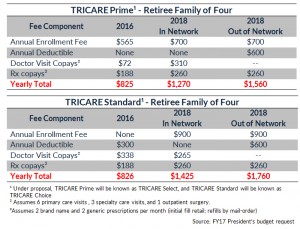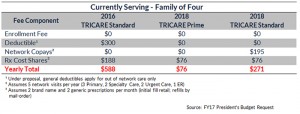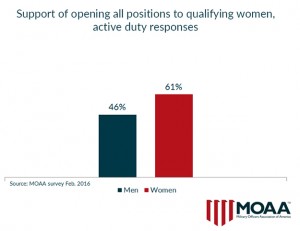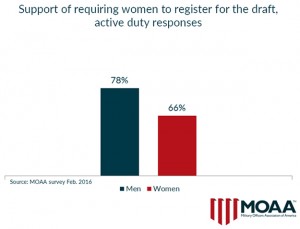We have No Action Items today
Summary of Issues
At Issue 1. we see HISTORY REPEATING. Budget targets TRICARE, pay, and commissary. The administration’s FY17 budget once again includes several proposals to shift more DoD costs to servicemembers, retirees, and families. (See Issue 1 below for the details. GF)
At Issue 2. we see TRICARE REFORM, OR JUST FEE INCREASES? President’s budget proposal hikes TRICARE costs. Proposal includes little detail on how to fix access and other problems. (See Issue 2 below for the details. GF)
At Issue 3. we see SURVEY SAYS: DRAFT REGISTRATION FOR ALL. Opening combat positions leads to calls for universal draft. As the military continues to introduce women into previously closed jobs, one final taboo remains. (See Issue 3 below for the details. GF)
At Issue 4. we see VA BUDGET BOOST DRAWS HILL ATTENTION. VA’s budget supports more transformational change. Will this budget produce much-needed reform?(See Issue 4 below for the details. GF)
At Issue 5. we see VETERANS PACKAGE CLEARS HOUSE. House passes controversial vet bill. Will this budget produce much-needed reform? (See Issue 5 below for the details. GF)
Collectively We Can and Are Making a Difference
FOR ALL, Please feel free to pass these Weekly Legislative Updates on to your group of Veteran Friends –
don’t be concerned with possible duplications – if your friends are as concerned as we are with Veteran issues, they probably won’t mind getting this from two or more friendly sources
ISSUES
Issue 1. HISTORY REPEATING
February 12, 2016
On Feb. 9, the administration unveiled its proposed FY17 budget. The request is strikingly similar to the administration’s budget proposal last year and once again calls for a military pay raise cap, commissary funding cuts, and higher TRICARE fees.
Military Pay and Retirement
Under the Pentagon budget proposal, servicemembers would receive a capped pay raise for the fourth year in a row. The proposed 1.6 percent pay raise is another .5 percent below the average American’s 2.1 percent raise, as measured by the Employment Cost Index (ECI). The proposed cap further expands the pay gap between the military and the private sector to 3.1 percent. The budget touts this as “the largest raise in four years;” but each of the last seven military raises have been lower than any raise during the previous 48 years. (Click on receive a capped pay raise here or above for more detail. GF)
The budget proposal also proposes adjustments to the new, blended retirement system that will take effect for new service entrants in 2018. The new system will cut military retired pay for this group by 20 percent, in order to provide up to a five percent government match to federal Thrift Savings Plan (TSP) accounts held by military members.
Under current law, government matching begins when a servicemember reaches three years of service. DoD proposes delaying government matching until the fifth year of service. The budget also proposes extending the government match – which stops at 26 years – until retirement, and increasing the government matching potential to 6 percent. The Pentagon is also pushing for greater flexibility on the continuation pay portion of the new system that comes at the 12 year mark.
MOAA supports improving the match and extending it for the full career, as other 401(k)-like programs do. But we’re not in favor of delaying the match until the fifth year of service for junior troops.
Commissary
One surprising proposal was a $221 million cut to commissary funding.
“That’s perplexing,” said MOAA President Lt. Gen. Dana Atkins, USAF (Ret). “Last year, the administration proposed cutting $300 million as the first step toward privatizing commissaries. After Congress restored the funding, administration officials agreed the benefit needs to be preserved, and they’d accept whatever level of savings might be realized by business efficiencies without reducing the benefit. To us, that’s inconsistent with proposing a $221 million cut. Without context, that seems considerably more than any efficiencies could be expected to generate in one year.”
MOAA will push to restore commissary funding to a level consistent with reasonable expectations of system efficiency improvements that won’t affect the value of the benefit.
Issue 2. TRICARE REFORM, OR JUST FEE INCREASES?
February 12, 2016
In the FY16 Defense Authorization Act, House and Senate leaders signaled their intent to pursue significant military health care reforms for FY17. They made it clear their intent was to improve care access and delivery. While they said they expected higher fees would be part of the reform, their focus would be on improving the benefit, not just raising beneficiary fees.
MOAA hoped to see some specific proposals in the FY17 budget to address well-documented problems with access, continuity of care, referrals, National Guard and Reserve programs and other documented healthcare problems.
In the briefing accompanying the budget rollout, Assistant Secretary of Defense for Health Affairs, Dr. Jonathan Woodson, said the budget includes initiatives to:
- Allow options to obtain urgent care without a referral
- Ensure “first-call resolution” on appointment requests
- Improve telehealth and quality measures
- Extend after-hours care at military facilities
- Enhance care for special-needs beneficiaries
MOAA certainly supports all of those initiatives, but awaits more details and explanation of how they will be worked into the system under current contracts.
In contrast, the budget was very specific in detailing a wide variety of fee changes and increases, including:
- Rebranding TRICARE Prime and TRICARE Standard as TRICARE Select and TRICARE Choice, respectively (for clarity purposes, we’ll continue to refer to them as Prime and Standard in the discussion below)
- Changing most copays for network provider visits to flat fees (out-of-network care would continue to have copays of 20 percent for active duty family members and 25 percent for retirees and family members),
- Establishing new annual “participation fees” for all retired members and families, under which those who didn’t pay the fee would be denied coverage for the year
- $350/$700 (single/family) for TRICARE Prime
- $450/900 for TRICARE Standard
- .5 percent to 2 percent of retired pay for a TFL-eligible couple, phased in over 5 years, with a complicated system of separate caps for flag officers and lower grades
- Establishing a zero deductible for Standard and Prime beneficiaries who use in-network providers, but a $300/$600 (single/family) annual deductible for care from out-of-network providers
- Raising the catastrophic cap (maximum out-of-pocket expenses) to $1,500 per year for currently serving families and $4,000 for retired families (vs. current $1,000 and $3,000)
- Roughly doubling most pharmacy copays via a 10-year schedule of increases
- Increasing all flat-dollar fee amounts annually by medical inflation (via a measure currently projected to increase at 6.2% per year)
- Exempting medical (Chapter 61) retirees and survivors whose sponsors died while on active duty from higher enrollment fees and copays paid by retired members
- Implementing the means-tested TRICARE For Life enrollment fee as of Jan. 2017, and the other changes as of Jan. 2018.
These are selected highlights of the proposals. We’ll provide additional details in next week’s update.
In the meantime, MOAA has done some calculations to illustrate how the cumulative changes would affect various categories of beneficiaries:
TFL beneficiaries would also be subjected to a means-tested enrollment fee, based on a percentage of retired pay. Means testing TFL beneficiaries is unprecedented and inappropriate for service-earned health coverage. It imposes financial penalties for longer and more successful service on a population that is already paying the highest fees of any military beneficiaries.
Current TFL beneficiaries would be grandfathered. Means-tested enrollment fees would be applied only to those attaining age 65 on or after January 1, 2017.
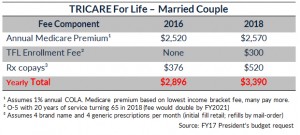
Active duty servicemembers and their families do well under the proposed budget, especially if they remain in Prime, and would have no copays for receiving care in network with a referral. Seeing a non-network provider would still incur a 20 percent cost share of the TRICARE allowable charge.
MOAA’s initial concerns about the proposals, in addition to the disproportional fee hikes, include:
- The focus on driving more care to military hospitals and clinics, when those facilities have been unable to accommodate current patient loads, as evidenced by appointment shortages and referral problems.
- Tying all health care fees, including premiums and copays, to a medical inflation index that is projected to grow at more than 6 percent a year. MOAA continues to believe fee adjustments should be capped at the annual COLA percentage.
- The continued effort to escalate pharmacy copays, which have already been doubled and tripled over the past 5 years.
- Requiring an annual decision to enroll and pay the “participation fee” or be denied care for a year.
- The failure to substantively address the need of Guard and Reserve members and families for more consistent and rational health coverage.
“It’s important to appreciate the budget submission is just the first step in a long process,” said MOAA President Lt Gen Atkins, USAF (Ret). “MOAA and our partners in The Military Coalition will be working with leaders and staffs of the House and Senate Armed Services committees in the coming months in our ongoing efforts to improve access and other problem areas while doing our best to protect against imposing disproportional fee increases on those who earned their military health care coverage through decades of service and sacrifice.”
Issue 3. SURVEY SAYS: DRAFT REGISTRATION FOR ALL
February 12, 2016
An informal survey by MOAA indicated many currently serving respondents (especially males) have doubts about the recent decision to open all combat positions to women. But most agreed (especially males) the next logical move, once that’s done, would be to require both men and women to register for the draft. (Come back and click on informal survey here or above for more detail. GF)
In MOAA’s survey, women were more likely to support opening all positions to women than their male counterparts were. Despite their support, women were somewhat less likely than men to think women should now register for the draft.
The results mirror the events at a recent Senate hearing, where representatives from the services offered mixed messages on the issue. At the hearing, the top generals in the Army and Marine Corps told Senate lawmakers that women should be required to register for the draft. The Secretary of the Navy and Acting Army Secretary were more nuanced in their responses, saying that the topic should be put to a national debate.
Issue 4. VA BUDGET BOOST DRAWS HILL ATTENTION
February 12, 2016
The Department of Veterans Affairs (VA) fared well in the administration’s proposed FY17 budget.
The $182.3 billion budget represents nearly an 86 percent increase in the department’s budget since 2009. This builds on Secretary Bob McDonald’s MyVA transformation initiative, which aims to make the department’s health and benefits systems more responsive to veterans and their families.
Much of VA’s budget – $103.6 billion – covers veterans’ disability compensation and pensions. For the first time, thanks to Congress’ new statutory mandate, VA’s budget includes $103.9 billion in advance appropriations for 2018, largely to protect veterans’ payments from stopping should the government shut down.The remaining $78.7 billion funds mostly health care programs and services, an almost 5 percent from this year. The budget also includes $70 billion for medical advance appropriations in 2018.Some lawmakers are skeptical about the VA’s growing cost and doubt the department will be able to fix systemic problems that remain.
“This budget request is almost double the VA budget in 2009, and since then, the VA has been plagued by scandals and mismanagement and has consistently proven its inability to use its existing resources,” said Senate Veterans Affairs Committee Chairman Johnny Isakson (R-Ga.). “The solution to fixing a broken agency is not simply giving it more money.
”At a House Veterans Affairs Committee hearing this week, McDonald stressed the importance of these funds in executing MyVA, including VA’s plan to consolidate all of its community care programs into a single, new Veterans Choice Program.In 2014, Congress provided $5 billion for VA to hire more physicians and staff and another $10 billion to improve access to non-VA providers under the Veterans Choice program. This funding will expire in 2017, leaving a great deal of uncertainty about future funding for the program.
Chairman Jeff Miller (R-Fla.) sent a clear message to officials at the hearing, saying, “I will fight to ensure VA has the resources it needs, but given the complete lack of accountability for the department’s string of past financial failures, this budget request will receive every bit the scrutiny it is due.
”There is no question that system-wide VA reform is necessary. MOAA will continue to work closely with lawmakers, the administration, and VA to help the department make needed cultural, efficiency, and capability changes to meet the needs of veterans and their families now and for the future.
Issue 5. VETERANS PACKAGE CLEARS HOUSE
February 12, 2016
On Tuesday, the House of Representatives passed the Veterans Employment, Education, and Health Care Improvement Act (H.R. 3016) which, among other things would:
- Extend the recently enacted Gunnery Sgt. Fry Scholarships to surviving spouses who lost their military spouse between 2001 and 2006. This group of survivors will have until 2021 to use GI Bill-equivalent benefits to complete college or job training.
- Make this same group eligible for matching additional funds by private colleges and the VA under the Yellow Ribbon program
- Raise Medal of Honor recipients to the first enrollment priority group and exempt them from all co-payments for inpatient, outpatient, long-term care, and prescriptions.
- Authorize newborn child care for women veterans receiving VA maternity care with post-delivery services for 14 days if the veteran delivered the child in a VA facility or contracted VA facility.
- Cap flight training payments paid through the Post-9/11 GI Bill to the same cap in place for tuition and fees at all private and for-profit colleges.
- Extend service credit for GI Bill eligibility purposes for time spent in medical hold by wounded, ill, and injured members who now may spend as much as a year or two in this status without GI Bill service credit.
- Increase the service requirement for eligibility to transfer GI Bill benefits to a spouse or child by requiring completion of 10 years plus a commitment to serve 2 more years (vs. the current 6 years plus 4 more).
- Reduce the housing allowance by 50 percent for dependent children whose sponsors transfer GI Bill benefits to them in the future (military spouses with transferred benefits will retain the full housing benefit).
The last item proved controversial, as the savings from this reduction is what funded the other improvements in the bill.
Last year, the Military Compensation and Retirement Modernization Commission Report recommended abolishing the housing allowance for GI Bill benefits transferred to spouses and children. Part of the rationale was that the benefit is set at the Basic Housing Allowance rate for an E-5 “with dependents” residing at the location of the college or university. The commission questioned whether that is appropriate when the spouse may remain at home or for a single child age 18-22.
Some lawmakers expressed concern that since transferability is open to all servicemembers who sign up for the additional service, it is perceived by military families as an earned benefit, rather than as the intended retention incentive it was designed to be, like reenlistment bonuses.
In the end, House members preserved the full housing allowance for spouses, who may need to use the benefit after the servicemember’s retirement.
But a majority felt the 50 percent allowance reduction for dependent children was not out of line, since most students are single and have roommates when they enter college, and the savings from the change was needed to fund the other important improvements.
MOAA would have preferred to find another way to pay for the other fixes, but appreciates the reduction would grandfather existing transferred contracts and apply only to new GI Bill transfers executed more than 180 days after the change is enacted. This will allow eligibles who haven’t yet transferred benefits to a child time to do so without incurring the allowance reduction.
That’s it for today- Thanks for your help!

